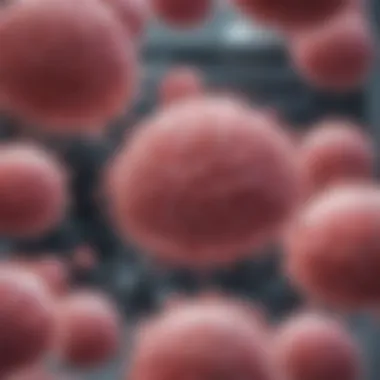Exploring Mutations in Triple Negative Breast Cancer


Intro
Triple negative breast cancer (TNBC) is a particularly challenging subtype of breast cancer. It is marked by the absence of estrogen receptors, progesterone receptors, and human epidermal growth factor receptor 2 (HER2). This absence signifies that typical hormone-based therapies, which work well in other breast cancer types, are ineffective in TNBC. Understanding the genetic mutations associated with this aggressive form of cancer is crucial for improving diagnosis and treatment options.
Initially, much of the focus on breast cancer treatment has been on hormonal therapies or therapies targeting HER2. However, TNBC presents a unique challenge, often resulting in poorer prognoses for patients. The need for targeted therapies arises because of the distinct molecular characteristics of TNBC, including a variety of genetic mutations. This discussion delves into the specific mutations related to TNBC, their clinical implications, and the potential future directions of research.
Methodology
Overview of research methods used
The exploration of genetic mutations in TNBC encompasses a range of research methodologies. Most studies focus on genomic sequencing techniques to identify mutations. Next-generation sequencing (NGS) has become a primary tool for uncovering the molecular landscape of TNBC. This method allows for the extensive examination of cancer genomes, enabling researchers to pinpoint specific mutations that drive the disease.
In conjunction with genomic sequencing, many studies utilize bioinformatics to analyze complex data sets. This interdisciplinary approach provides insight into the biological significance of identified mutations, allowing for potential therapeutic targets to emerge.
Data collection techniques
Data collection techniques in TNBC research often involves both tissue samples and clinical data. Biopsies from TNBC patients are collected, and genomic data are extracted and analyzed. Researchers also gather clinical information alongside molecular data to assess the correlation between specific mutations and clinical outcomes. This approach enhances the understanding of how genetic mutations influence prognosis and treatment responses.
Furthermore, multicenter collaborations have become instrumental in gathering diverse data. By pooling resources and data across institutions, research teams can increase sample sizes, enabling more robust conclusions about mutations in TNBC and their implications.
"The integration of genomic data with clinical information is essential in devising personalized treatment strategies for TNBC patients."
Future Directions
Upcoming trends in research
As the field of oncology continues to evolve, several trends in TNBC research are becoming prominent. Immunotherapy is emerging as a promising avenue, with checkpoint inhibitors like pembrolizumab leading the way. Ongoing clinical trials are aimed at understanding the efficacy of such therapies in TNBC patients. The role of tumor-infiltrating lymphocytes, a type of immune cell, is also gaining attention as they may contribute to the effectiveness of immunotherapy.
Areas requiring further investigation
Despite advancements, various areas still need more exploration. There remain significant gaps in understanding the complete molecular biology of TNBC. For instance, while certain mutations like TP53 and BRCA1/2 are well-documented, other mutations potentially driving the disease are still unknown. Additionally, understanding how these mutations interact with the tumor microenvironment is critical in developing effective therapies.
Future studies need to focus on comprehensive profiling of TNBC tumors. This could uncover novel therapeutic targets that could be exploited for clinical benefit. The integration of liquid biopsy techniques may also enhance patient monitoring and treatment response assessment while minimizing procedural risks associated with traditional biopsies.
Prelims to Triple Negative Breast Cancer
Triple Negative Breast Cancer (TNBC) is a complex and often challenging form of breast cancer. Its unique characteristics require a thorough understanding to optimize treatment strategies and improve patient outcomes. This section elaborates on the defining features of TNBC and its epidemiological context, providing a foundational knowledge that is crucial for grasping the intricacies of the disease.
Defining Triple Negative Breast Cancer
Triple negative breast cancer is defined by the absence of three significant receptors: estrogen, progesterone, and the human epidermal growth factor receptor 2 (HER2). This means that standard hormonal therapies typically effective for other breast cancers have limited application here. TNBC accounts for approximately 10-20% of all breast cancer diagnoses, making its unique profile particularly important in cancer research and treatment development. Understanding how TNBC deviates from other breast cancer subtypes can assist in identifying tailored approaches to therapy and patient management.


In practical terms, this lack of specific receptors is not just a clinical categorization; it fundamentally impacts treatment routes. Patients diagnosed with TNBC often face more aggressive tumor behavior and a higher likelihood of metastasis. Therefore, recognizing the establish boundaries of TNBC is essential in order to both inform patient prognosis and guide clinical decisions.
Epidemiology and Risk Factors
The epidemiology of TNBC highlights its prevalence among various demographics. Research indicates that TNBC is more commonly diagnosed in younger women, particularly those under 40 years of age, and is more prevalent among African American and Hispanic populations compared to Caucasian women. These disparities underscore the importance of demographic factors in cancer screening and diagnosis, as well as implications for targeted interventions within vulnerable communities.
Several risk factors have been associated with developing TNBC, including genetics, family history, and lifestyle choices. For example, mutations in the BRCA1 gene are strongly correlated with an increased risk of TNBC. Additionally, factors such as obesity, alcohol consumption, and a lack of physical activity can contribute to the likelihood of developing this subtype. Understanding these risk factors is crucial in developing preventive strategies and informing patients of their individual risks.
"Identifying the unique risk factors related to TNBC can profoundly influence detection strategies and patient education, potentially leading to earlier diagnosis and improved outcomes."
Through examining the unique features of TNBC and the epidemiological context surrounding it, healthcare professionals can better contextualize data related to genetic mutations and treatment options discussed later in this article. The knowledge acquired in this introductory section lays an essential groundwork for deepening the understanding of triple negative breast cancer and its complexities.
Molecular Characteristics of Triple Negative Breast Cancer
The molecular characteristics of triple negative breast cancer (TNBC) are critical for understanding its unique behavior and treatment challenges. TNBC is not merely defined by the absence of hormone receptors; its molecular profile significantly influences clinical outcomes. By examining these characteristics, we gain insights into TNBC’s pathogenesis and the factors that drive its aggressiveness, aiding in the development of targeted therapies.
Lack of Hormone Receptors
One of the most defining aspects of TNBC is the absence of estrogen receptors, progesterone receptors, and the human epidermal growth factor receptor 2 (HER2). This lack is not just an incidental finding; it has profound implications for treatment. Without these receptors, traditional hormone therapies such as tamoxifen or aromatase inhibitors are ineffective.
The absence of hormone receptors means TNBC tends to be more aggressive than other breast cancer subtypes. This aggression is linked to higher rates of metastasis and recurrence. Studies show that TNBC patients often present with larger tumors at diagnosis. Furthermore, because these tumors do not express HER2, they cannot benefit from HER2-targeted therapies like trastuzumab.
Recent research also indicates that the lack of hormone receptors may correlate with specific genetic mutations, particularly in the BRCA1 gene. The interplay between these mutations and hormone receptor status shapes the clinical approach to TNBC, making it crucial for researchers and clinicians to focus on these molecular features.
Presence of Basal-like Subtype
Many TNBC cases are classified as basal-like, a subtype that exhibits distinct molecular features. Basal-like TNBC typically has a high proliferation rate, increased chances of metastasis, and a tendency for early recurrence. This tumor subtype often expresses genes associated with basal epithelial cells rather than luminal epithelial cells, which characterizes most breast cancers.
Basal-like tumors are often associated with mutations in key genes, including TP53 and BRCA1. Understanding the characteristics of this subtype is essential for developing effective treatments. Researchers are currently investigating novel therapeutic agents that target the specific pathways active in basal-like TNBC.
"The basal-like subtype of TNBC is a significant area of study due to its unique molecular characteristics and treatment challenges."
Genetic Mutations Associated with TNBC
Understanding genetic mutations associated with triple negative breast cancer (TNBC) is essential for several reasons. These mutations not only inform the biological behavior of TNBC but also guide therapeutic decisions and patient management. The unique profile of genetic alterations found in TNBC allows researchers and clinicians to develop targeted strategies tailored to the individual's tumor characteristics. This section delves into three significant mutations: BRCA1, TP53, and PIK3CA, which are paramount to understanding TNBC's pathology and treatment.
BRCA1 and BRCA2 Mutations
BRCA1 and BRCA2 mutations are key drivers of hereditary breast cancer. Individuals with these mutations carry a heightened risk of developing TNBC. Approximately 15-20% of TNBC cases exhibit a genetic link to these mutations. The role of BRCA1, in particular, is crucial as it functions in DNA repair. When mutated, BRCA1 leads to a loss of this essential repair mechanism. Consequently, the tumor's genomic instability increases, contributing to a more aggressive disease and poorer prognosis.
Research suggests that patients with BRCA-associated TNBC may respond differently to certain chemotherapies. For instance, these patients often show increased sensitivity to platinum-based agents, such as carboplatin. This insight has significant implications for treatment planning. Genetic testing for BRCA mutations is increasingly becoming a standard practice in TNBC diagnosis, leading to more personalized patient care.
TP53 Mutations


Mutations in the TP53 gene are among the most frequently observed changes in TNBC. TP53 encodes the p53 protein, which acts as a tumor suppressor. Its primary role is to regulate the cell cycle and maintain genomic stability. When the TP53 gene is mutated, the cell loses its ability to control division and repair DNA damage. This loss contributes to tumor development, allowing the cancer cells to proliferate uncontrollably.
Estimates indicate that TP53 mutations occur in about 80% of TNBC cases, highlighting its crucial role in the disease's aggressiveness. The presence of TP53 mutations not only correlates with poor outcomes but also with treatment resistance. Patients with TP53 mutations may have more aggressive disease and may not respond well to standard therapies, which necessitates ongoing research into alternative treatment avenues.
PIK3CA Mutations
The PIK3CA gene is associated with the phosphatidylinositol 3-kinase pathway, crucial for cell growth and proliferation. Mutations in this gene can lead to aberrant signaling pathways that promote cancer cell survival and growth, impacting TNBC behaviors. Approximately 10-20% of patients with TNBC have mutations in the PIK3CA gene, which could also influence tumor progression and response to treatments.
Emerging evidence suggests that targeting the PIK3CA pathway may provide new therapeutic options for TNBC patients with these specific mutations. Clinical studies are ongoing to evaluate PI3K inhibitors in this patient population, offering hope for improved outcomes. Understanding the implications of PIK3CA mutations in TNBC will be instrumental in shaping future targeted therapies.
"Identifying genetic mutations in TNBC allows for a better understanding of tumor behavior and provides avenues for developing specialized treatment strategies."
Impact of Mutations on Tumor Behavior
The understanding of mutations within triple negative breast cancer (TNBC) is pivotal when examining tumor behavior. Mutations affect not only the biological characteristics of the cancer cells but also their response to treatment and overall aggressiveness. This section discusses two primary aspects of mutation impact: the aggressiveness and metastasis of TNBC tumors, and the resistance these tumors exhibit against common treatment strategies.
Aggressiveness and Metastasis
Triple negative breast cancer is often noted for its aggressive nature. Genetic mutations play a significant role in this aggressive behavior. For instance, mutations in the TP53 gene are frequently observed in TNBC cases. This gene is crucial for regulating the cell cycle, and its alteration can lead to uncontrolled cell division. As a result, the presence of such mutations can mean more rapid tumor growth and an increased likelihood of metastasis.
Surgical findings often reveal that TNBC tends to be diagnosed at later stages. This can be linked to the aggressive nature of the disease and its tendency to metastasize early. Metastasis, defined as the spread of cancer cells to distant sites in the body, is a hallmark of TNBC. The higher chance of metastasis is concerning for patients and healthcare professionals alike, leading to poorer overall survival rates compared to other breast cancer subtypes.
The connection between specific mutations and aggressive behavior emphasizes the need for early detection and vigilant monitoring. Researchers aim to identify biomarkers that could predict which tumors are more likely to behave aggressively.
Treatment Resistance
Another crucial area impacted by mutations is treatment resistance. TNBC does not express hormone receptors, rendering conventional hormonal therapies ineffective. Furthermore, the various genetic mutations present in TNBC contribute to a notable resistance to chemotherapy and targeted therapies, which complicates treatment plans.
For example, tumors harboring mutations in the BRCA1 or BRCA2 genes may initially respond to certain treatments but can develop resistance over time. Resistance mechanisms may include enhanced DNA repair capabilities or changes in the tumor microenvironment that shield the cancer from the therapeutic effects.
Patient outcomes can significantly vary based on mutation profiles. Customized treatment plans based on genetic analysis of the tumor can improve survival and response rates. Therefore, understanding these mutations is paramount for oncologists when choosing the best therapeutic approach.
"Careful analysis of genetic mutations not only helps in predicting tumor behavior but also forms the basis for devising effective personalized treatment strategies."
In summary, mutations in TNBC coexist with meanings that go beyond their genetic coding. The association between mutations and tumor behavior, especially regarding aggressiveness and resistance to treatment, underscores the complexities involved. Continuous research is essential to navigate these challenges, aiming for better diagnostic and therapeutic options that could ultimately improve patient outcomes.
Current Treatment Strategies for TNBC
Triple negative breast cancer (TNBC) presents unique challenges in treatment due to its lack of hormone receptors and overexpressed HER2 protein. This absence makes traditional treatment options less effective. Currently, treatment strategies often involve a combination of therapies that are tailored to individual cases. This section explores the important approaches that are commonly utilized in managing TNBC, highlighting their benefits and considerations.
Chemotherapy Approaches
Chemotherapy remains a cornerstone in the treatment of TNBC. The aggressive nature of this cancer makes chemotherapy particularly relevant. Common regimens include combinations of drugs such as doxorubicin, cyclophosphamide, and paclitaxel. These agents work together to disrupt cancer cell division and can lead to significant tumor reduction.


However, chemotherapy can also bring challenges. Side effects such as nausea, fatigue, and potential for long-term health impacts are commonplace. Patients often need to weigh the effectiveness of chemotherapy against these side effects. Furthermore, sequencing and timing of chemotherapy can greatly influence treatment outcomes, making careful planning essential.
Immunotherapy in TNBC
Immunotherapy is an emerging strategy that shows promise for treating TNBC. Treatments like pembrolizumab, which targets the PD-1 pathway, are being investigated. By helping the immune system recognize and attack cancer cells, immunotherapy has the potential to improve outcomes in patients who may not respond well to conventional therapies.
The effectiveness of immunotherapy can vary based on the tumor's characteristics. Biomarkers such as PD-L1 expression can guide clinicians in selecting patients who are more likely to benefit from this approach. Yet, immunotherapy alone may not be sufficient for all patients, and its use is often combined with chemotherapy to enhance treatment efficacy.
Targeted Therapies
Targeted therapies represent another avenue for treatment in TNBC. These therapies aim to specifically target genetic mutations present in tumors. For instance, PARP inhibitors like olaparib are used in patients with BRCA1 or BRCA2 mutations, aiming to exploit the vulnerabilities in cancer cells caused by these mutations.
While targeted therapies can enhance treatment specificity, they also require careful patient selection. Genomic testing can aid in identifying appropriate candidates. By matching therapies to tumor genetics, these strategies may lead to better outcomes but often come with their own set of challenges, from managing side effects to insurance coverage limitations.
"The landscape of treatment for TNBC is rapidly evolving. Clinicians must stay informed on the latest developments to optimize patient care."
Emerging Research and Future Directions
Emerging research in the field of triple negative breast cancer (TNBC) is crucial for enhancing our understanding of its complexities and finding effective treatments. As the landscape of cancer treatment evolves, ongoing investigations shed light on novel strategies that target genetic vulnerabilities within TNBC. This area of research not only addresses urgent clinical needs but also opens avenues for personalized therapies that could improve patient outcomes. By continuously exploring the mechanisms of tumor behavior and responses to therapies, scientists are paving the way for significant advancements in the clinical setting.
Novel Therapeutic Agents
The search for new therapeutic agents to combat TNBC has gained momentum in recent years. Researchers are investigating various compounds that can selectively target the underlying molecular defects present in TNBC cells. Some of these promising agents include:
- PARP inhibitors like Olaparib, which show effectiveness in tumors with BRCA mutations.
- Antibody-drug conjugates that deliver chemotherapy directly to cancer cells, minimizing collateral damage to surrounding healthy tissue.
- Cytokine-based therapies that may enhance immune response against tumors.
These agents have the potential to change how TNBC is treated, leading to improved management strategies that accommodate the unique characteristics of the disease. As clinical trials continue to evaluate their safety and efficacy, a new era of targeted therapies could emerge, providing hope for patients with this aggressive form of breast cancer.
Genomic Testing and Personalized Medicine
Genomic testing plays a critical role in the advancement of personalized medicine for TNBC. It allows for the identification of mutations and alterations specific to an individual’s tumor. This information is vital for tailoring treatment plans that fit the unique genetic profile of the cancer. Key benefits of genomic testing include:
- Identification of actionable mutations that guide therapy selection.
- Enhanced understanding of disease prognosis based on genetic factors.
- Development of clinical trial options based on molecular characteristics of the tumor.
Closure
In this section, we will provide a synthesis of key findings from our exploration of triple negative breast cancer (TNBC) mutations. Understanding TNBC is crucial due to its unique challenges and treatment considerations. This cancer subtype presents distinct mutations that inform various aspects of its pathology and guide therapeutic decisions. The genetic landscape we outlined features significant mutations, especially in genes like BRCA1, BRCA2, TP53, and PIK3CA, which play essential roles in tumor behavior and treatment response.
Summarizing the Key Insights
Triple negative breast cancer is not only defined by its lack of receptor presence but also by the intricate mutations that alter the behavior of the tumors. These mutations contribute to both the aggressive nature of TNBC and the resistance to standard therapies. Key insights include the following:
- Lack of Hormone Receptors: TNBC is characterized by the absence of estrogen, progesterone, and HER2 receptors, making conventional hormone therapies ineffective.
- Genetic Mutations: Understanding the specific mutations such as those in BRCA1 and BRCA2 can lead to tailored therapeutic strategies.
- Aggressive Behavior: TNBC is usually more aggressive and presents a higher risk of metastasis, emphasizes the need for personalized treatment plans.
"The growing knowledge about TNBC mutations is essential for developing more effective treatment strategies."
The Importance of Continued Research
Ongoing research is vital for several reasons. First, the understanding of TNBC's molecular characteristics continues to evolve. As new therapeutic agents emerge, insights from genomic testing can lead to more personalized approaches in treating this challenging subtype of breast cancer. Continuous exploration can also uncover other potential mutations that may influence treatment responses. Overall, the investment in research for TNBC will contribute significantly to improving patient outcomes and understanding this disease further.







